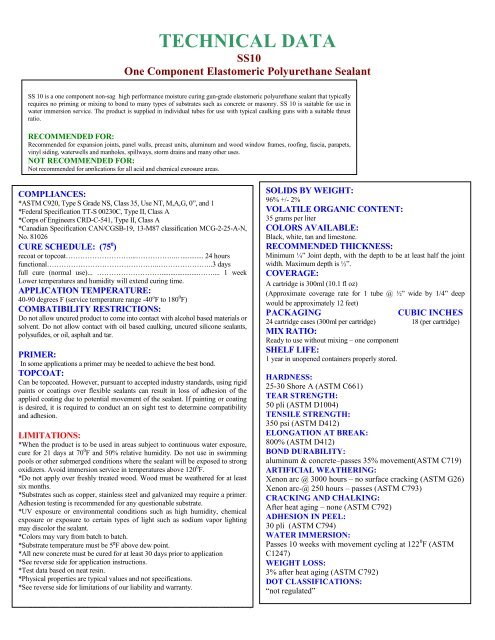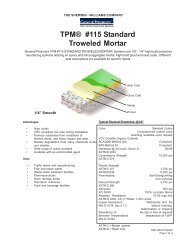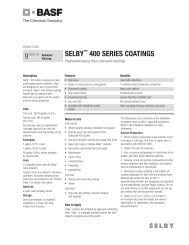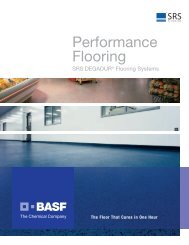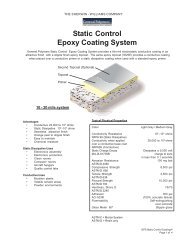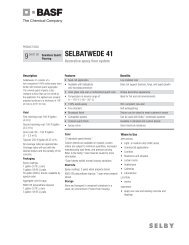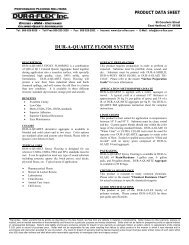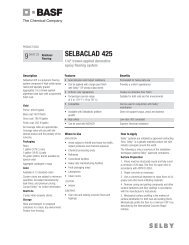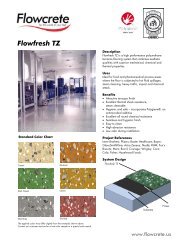TECHNICAL DATA - Industrial Epoxy Flooring for Concrete ...
TECHNICAL DATA - Industrial Epoxy Flooring for Concrete ...
TECHNICAL DATA - Industrial Epoxy Flooring for Concrete ...
Create successful ePaper yourself
Turn your PDF publications into a flip-book with our unique Google optimized e-Paper software.
<strong>TECHNICAL</strong> <strong>DATA</strong><br />
SS10<br />
One Component Elastomeric Polyurethane Sealant<br />
SS 10 is a one component non-sag high per<strong>for</strong>mance moisture curing gun-grade elastomeric polyurethane sealant that typically<br />
requires no priming or mixing to bond to many types of substrates such as concrete or masonry. SS 10 is suitable <strong>for</strong> use in<br />
water immersion service. The product is supplied in individual tubes <strong>for</strong> use with typical caulking guns with a suitable thrust<br />
ratio.<br />
RECOMMENDED FOR:<br />
Recommended <strong>for</strong> expansion joints, panel walls, precast units, aluminum and wood window frames, roofing, fascia, parapets,<br />
vinyl siding, waterwells and manholes, spillways, storm drains and many other uses.<br />
NOT RECOMMENDED FOR:<br />
Not recommended <strong>for</strong> applications <strong>for</strong> all acid and chemical exposure areas.<br />
COMPLIANCES:<br />
*ASTM C920, Type S Grade NS, Class 35, Use NT, M,A,G, 0”, and 1<br />
*Federal Specification TT-S 00230C, Type II, Class A<br />
*Corps of Engineers CRD-C-541, Type II, Class A<br />
*Canadian Specification CAN/CGSB-19, 13-M87 classification MCG-2-25-A-N,<br />
No. 81026<br />
CURE SCHEDULE: (75°)<br />
recoat or topcoat………………………...……………..…............ 24 hours<br />
functional………………………………………..…………………..3 days<br />
full cure (normal use)... ……………………….....................…….... 1 week<br />
Lower temperatures and humidity will extend curing time.<br />
APPLICATION TEMPERATURE:<br />
40-90 degrees F (service temperature range -40 o F to 180 0 F)<br />
COMBATIBILITY RESTRICTIONS:<br />
Do not allow uncured product to come into contact with alcohol based materials or<br />
solvent. Do not allow contact with oil based caulking, uncured silicone sealants,<br />
polysufides, or oil, asphalt and tar.<br />
PRIMER:<br />
In some applications a primer may be needed to achieve the best bond.<br />
TOPCOAT:<br />
Can be topcoated. However, pursuant to accepted industry standards, using rigid<br />
paints or coatings over flexible sealants can result in loss of adhesion of the<br />
applied coating due to potential movement of the sealant. If painting or coating<br />
is desired, it is required to conduct an on sight test to determine compatibility<br />
and adhesion.<br />
LIMITATIONS:<br />
*When the product is to be used in areas subject to continuous water exposure,<br />
cure <strong>for</strong> 21 days at 70 0 F and 50% relative humidity. Do not use in swimming<br />
pools or other submerged conditions where the sealant will be exposed to strong<br />
oxidizers. Avoid immersion service in temperatures above 120 0 F.<br />
*Do not apply over freshly treated wood. Wood must be weathered <strong>for</strong> at least<br />
MIXING AND APPLICATION<br />
six months.<br />
*Substrates such as copper, stainless steel and galvanized may require a primer.<br />
Adhesion testing is recommended <strong>for</strong> any questionable substrate.<br />
*UV exposure or environmental INSTRUCTIONS conditions such as high (NP10) humidity, chemical<br />
exposure or exposure to certain types of light such as sodium vapor lighting<br />
may discolor the sealant.<br />
1) PRODUCT STORAGE: Store product in an area so as to bring<br />
*Colors may vary from batch to batch.<br />
the material to normal room temperature at least 24 hours be<strong>for</strong>e<br />
*Substrate temperature must be 5°F above dew point.<br />
*All using. new concrete Continuous must be storage cured <strong>for</strong> should at least be 30 days between prior to 50-70°F. application Store away<br />
*See from reverse heat side and <strong>for</strong> direct application sunshine. instructions. Storing at elevated temperatures will<br />
*Test reduce data based the shelf on neat life. resin.<br />
*Physical properties are typical values and not specifications.<br />
*See 2) reverse SURFACE side <strong>for</strong> limitations PREPARATION: of our liability All and warranty. dirt, oil, dust, <strong>for</strong>eign<br />
contaminants and laitance must be removed to assure a trouble free<br />
bond to the substrate. We recommend that all loose concrete,<br />
SOLIDS BY WEIGHT:<br />
96% +/- 2%<br />
VOLATILE ORGANIC CONTENT:<br />
35 grams per liter<br />
COLORS AVAILABLE:<br />
Black, white, tan and limestone.<br />
RECOMMENDED THICKNESS:<br />
Minimum ¼” Joint depth, with the depth to be at least half the joint<br />
width. Maximum depth is ½”.<br />
COVERAGE:<br />
A cartridge is 300ml (10.1 fl oz)<br />
(Approximate coverage rate <strong>for</strong> 1 tube @ ½” wide by 1/4” deep<br />
would be approximately 12 feet)<br />
PACKAGING<br />
CUBIC INCHES<br />
24 cartridge cases (300ml per cartridge) 18 (per cartridge)<br />
MIX RATIO:<br />
Ready to use without mixing – one component<br />
SHELF LIFE:<br />
1 year in unopened containers properly stored.<br />
HARDNESS:<br />
25-30 Shore A (ASTM C661)<br />
TEAR STRENGTH:<br />
50 pli (ASTM D1004)<br />
TENSILE STRENGTH:<br />
350 psi (ASTM D412)<br />
ELONGATION AT BREAK:<br />
800% (ASTM D412)<br />
BOND DURABILITY:<br />
aluminum & concrete–passes 35% movement(ASTM C719)<br />
ARTIFICIAL WEATHERING:<br />
Xenon arc @ 3000 hours – no surface cracking (ASTM G26)<br />
Xenon arc-@ 250 hours – passes (ASTM C793)<br />
CRACKING AND CHALKING:<br />
After heat aging – none (ASTM C792)<br />
ADHESION IN PEEL:<br />
30 pli (ASTM C794)<br />
WATER IMMERSION:<br />
Passes 10 weeks with movement cycling at 122 0 F (ASTM<br />
C1247)<br />
WEIGHT LOSS:<br />
3% after heat aging (ASTM C792)<br />
DOT CLASSIFICATIONS:<br />
“not regulated”
previous joint compound, oil, grease, asphalt, tar, wax, rust or other <strong>for</strong>eign material be removed to leave a clean sound joint. For<br />
concrete, stone or other masonry, clean by sand blasting or wire brushing to expose a sound surface. Wood should be weathered, clean<br />
and sound. Scrape away loose paint to bare wood. Any coating that cannot be removed from the wood must be tested to verify adhesion.<br />
On metal, remove scale, rust and coatings to expose a bright white surface. Remove any protective coatings, chemical residue or films on<br />
the metal. Remove any other protective coatings or finishes that could interfere with adhesion.<br />
3) PRIMER: This product is generally considered a nonpriming sealant. However, some surfaces such as copper, stainless steel, Kynar and galvanized<br />
may require the use of a suitable primer. An adhesion test is recommended <strong>for</strong> any other questionable substrate. It is the user’s responsibility to check the<br />
adhesion of the cured sealant on typical test joints at the project sight be<strong>for</strong>e and during the application.<br />
4) PRODUCT MIXING: Normally no mixing is required.<br />
5) PRODUCT APPLICATION: This sealant comes ready to use. Apply with a professional caulking gun with an 18:1 thrust or other suitable<br />
equipment. Do not open cartridges until preparatory work has been completed. The number of joints and the joint width should be designed <strong>for</strong> a<br />
maximum of +/- 25% movement. Fill joints from the deepest point to the surface by holding a properly sized nozzle against the back of the joint. Dry<br />
tooling is recommended. Do not use soapy water when tooling. Proper tooling results in the correct bead shape, a neat joint and maximum adhesion. For<br />
roof tile applications, apply a bead of sealant sufficient to make bond between two tiles on the upper surface of the down slope tile. Install the upslope tile<br />
and press into the sealant bead to ensure good contact between the sealant and both tiles. In deep joints, the sealant depth must be controlled by closed<br />
cell backer rod or soft backer rod. Where the joint depth does not permit the use of a backer rod, a bondbreaker (polyethylene strip) must be used to<br />
prevent three point bonding. When using a backer rod, compress and roll it into the joint channel without stretching it lengthwise. Closed cell backer rod<br />
should be about 1/8” larger in diameter than the width to allow <strong>for</strong> compression. Soft backer rods should be 24% larger in diameter than the joint width.<br />
Approximate Linear feet per Cartridge<br />
Joint Width<br />
Joint Depth ¼” 3/8” ½” 5/8” ¾” 7/8” 1”<br />
¼” 25.7 lineal feet 17.1 lineal feet 12.8 lineal feet 10.2 lineal feet n/a n/a n/a<br />
3/8” n/a n/a n/a 6.8 lineal feet 5.7 lineal feet 4.8 lineal feet 4.3 lineal feet<br />
½” n/a n/a n/a n/a 4.3 lineal feet 3.7 lineal feet 3.2 lineal feet<br />
6) RECOAT OR TOPCOATING: No recoating or topcoating is necessary. However, if you opt to topcoat the applied joint compound,<br />
allow it to cure be<strong>for</strong>e topcoating. It is not necessary to prime over the joint compound prior to topcoating the joint compound. Many<br />
epoxies and urethanes can be used. In some instances, especially when excessive expansion joint movement is involved, topcoats may<br />
chip, crack or disbond. However, most epoxy or topcoat products will adhere to the joint compound very well.<br />
7) CLEANUP: Immediately after use, clean equipment with xylene or other suitable solvents. Remove cured sealant by cutting with a sharp edged tool.<br />
Remove thin films by abrading.<br />
8) RESTRICTIONS: Restrict the use of the area where the sealant has been applied until the product is sufficiently cured. Do not apply<br />
when rain is imminent or freezing temperatures are expected.<br />
NOTICE TO BUYER: DISCLAIMER OF WARRANTIES AND<br />
LIMITATIONS ON OUR LIABILITY<br />
We warrant that our products are manufactured to strict quality assurance specifications and that the in<strong>for</strong>mation supplied by us is accurate to the best of<br />
our knowledge. Such in<strong>for</strong>mation supplied about our products is not a representation or a warranty. It is supplied on the condition that you shall make your<br />
own tests to determine the suitability of our product <strong>for</strong> your particular purpose. Any use or application other than recommenced herein is the sole<br />
responsibility of the user. Listed physical properties are typical and should not be construed as specifications. NO WARRANTY IS MADE,<br />
EXPRESSED OR IMPLIED, REGARDING SUCH OTHER INFORMATION, THE <strong>DATA</strong> ON WHICH IT IS BASED, OR THE RESULTS YOU<br />
WILL OBTAIN FROM ITS USE. N0 WARRANTY IS MADE, EXPRESSED OR IMPLIED, THAT OUR PRODUCT SHALL BE<br />
MERCHANTABLE OR THAT OUR PRODUCT SHALL BE FIT FOR ANY PARTICULAR PURPOSE. NO WARRANTY IS MADE THAT THE<br />
USE OF SUCH INFORMATION OR OUR PRODUCT WILL NOT INFRINGE UPON ANY PATENT. We shall have no liability <strong>for</strong> incidental or<br />
consequential damages, direct or indirect. Our liability is limited to the net selling price of our product or the replacement of our product, at our option.<br />
Acceptance of delivery of our product means that you have accepted the terms of this warranty whether or not purchase orders or other documents state<br />
terms that vary from this warranty. No representative is authorized to make any representation or warranty or assume any other liability on our behalf with<br />
any sale of our products. Our products contain chemicals that may CAUSE SERIOUS PHYSICAL INJURY. BEFORE USING, READ THE<br />
MATERIAL SAFETY <strong>DATA</strong> SHEET AND FOLLOW ALL PRECAUTIONS TO PREVENT BODILY HARM.<br />
COPYRIGHT 3/16/11 NATIONAL POLYMERS INC.


